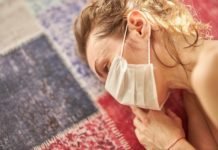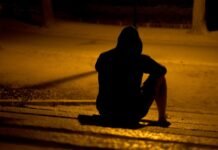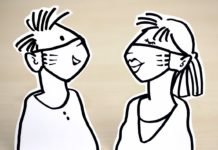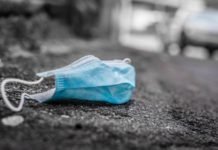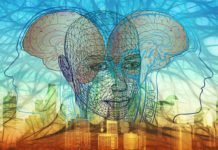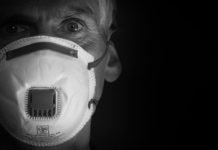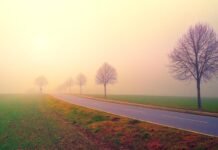The novel coronavirus (also known as COVID-19) has brought the world into uncharted waters. Whole countries are on lockdown, the economy has ground to a halt, and many people are afraid for themselves and their loved ones. With such unprecedented changes coming on so quickly, it’s understandable that the importance of sleep is flying under the radar. This study investigated the difference between male and female in sleep-wake pattern. A total of 60 data collected through online. 30 adolescence male and 30 adolescence female scale was used for this research is Sleep Pattern Assessment Questionnaire (SWPAQ) is devised Putilov A A (2000). Snow ball sampling method used to collect samples from different part of Kerala. The result shows that there is no significant difference (p>.05) in Eysenck personality score among male adolescence internet game addicts and non addicts. The results indicate there is a significant difference in sub scales of sleep -wake pattern like Morningness (M) (t=2.22, p>.05), and Eveningness (E) (t=3.22., p>.05) but no significant difference in Quality Of Night Time Sleep(S) (t=.598, p>.05). Males show higher score in ‘Morningness’ compare to female and female shows higher ‘Eveningness’ compare to male.
Sleep plays a vital role in brain function and systemic physiology across many body systems. Problems with sleep are widely prevalent and include deficits in quantity and quality of sleep; sleep problems that impact the continuity of sleep are collectively referred to as sleep disruptions. Numerous factors contribute to sleep disruption, ranging from lifestyle and environmental factors to sleep disorders and other medical conditions. Sleep disruptions have substantial adverse short- and long-term health consequences. Elevated stress and an overload of information can keep the mind racing and elevate the body’s arousal system response, triggering insomnia. People are spending every waking moment getting one last look at their screens (news updates, COVID-19 education, social connections). The blue light from these screens tells the brain to stop producing the sleep hormone melatonin, which can lead to trouble falling asleep. Also, loss of daytime structure can upset night-time sleep schedules. Inconsistent bedtimes and wake times can shift the pressure, or urge, to sleep, making ability to fall asleep less predictable. Finally, depressed mood, more downtime and low energy can increase long napping, making it harder to fall asleep at night (University Of Chicago Medicine.) Anxieties related to loss of control and uncertainty are understandable as we shelter in place during the COVID-19 pandemic. Focusing on sleep is a natural fit for working on self-care, as we know that getting enough sleep can benefit your immune system. When it comes to your health, sleep plays an important role. Sleep empowers an effective immune system. Solid nightly rest strengthens our body’s defences, and studies have even found that lack of sleep can make some vaccines less effective. Sleep heightens brain function. Our mind works better when we get good sleep, contributing to complex thinking, learning, memory, and decision-making. For adults and children adapting to work and school at home, good sleep can help them stay sharp. Sleep enhances mood. Lack of sleep can make a person irritable, drag down their energy level, and cause or worsen feelings of depression. Sleep improves mental health. Besides depression, studies have found that a lack of sleep is linked with mental health conditions like anxiety disorder, bipolar disorder, and Post-Traumatic Stress Disorder (PTSD).While more sleep won’t necessarily prevent you from getting sick, skimping on it could adversely affect your immune system, leaving you susceptible to a bad cold or case of the flu.( Sleep Foundation.Org).
The timing, duration and structure of sleep are regulated by processes related to both sleep homeostasis and circadian (~24 h) rhythmicity. Sleep homeostasis implies that sleep serves a recovery function, although the timing of recovery is modulated by the biological circadian clock. Variation in sleep duration may reflect differences in either the sleep homeostatic process or the circadian process. More specifically, these variations may reflect differences in the rate of build-up of sleep “need” during wakefulness, in the rate of dissipation of sleep “need” during sleep, in the amount of sleep people select to take, or modulation by circadian, environmental, behavioral or social factors. There is no consensus within the sleep research community as to which interpretation is correct. In fact, the significance and interpretation of variations in sleep duration and whether or not our society is chronically sleep-deprived is the subject of lively debate;Deboer T(2018).
The mechanisms by which an irregular sleep schedule develops in young adults are not well understood; however, they are likely to be multi-factorial, including biological, behavioural, and so population, in accordance with which people may be classified as being of a social factor. Two endogenous circadian rhythm patterns of alertness and sleepiness have been observed in the general p morning type (M-type) or an evening type (E-type). The sleep/wake schedule of these types differs, with the E-type associated with irregular sleeping habits and an increased need for sleep. In addition to biological factors, social cues, activity types and levels, environmental factors, and motivation to maintain a regular bedtime all also play important roles in entraining the sleep-wake cycle by adjusting the intrinsic (endogenously regulated) circadian rhythm. Studies have shown that even partial sleep deprivation has a significant effect on mood. University of Pennsylvania researchers found that subjects who were limited to only 4.5 hours of sleep a night for one week reported feeling more stressed, angry, sad, and mentally exhausted. When the subject resumed normal sleep, they reported dramatic improvement in mood Not only does sleep affect mood, but mood and mental states can also affect sleep. Anxiety increases agitation and arousal, which make it hard to sleep. Stress also affects sleep by making the body aroused, awake, and alert. People who are under constant stress or who have abnormally exaggerated responses to stress tend to have sleep problems. Namni G (2014)
A literature search was conducted to provide a non-systematic review of these health consequences (this review was designed to be non-systematic to better focus on the topics of interest due to the myriad parameters affected by sleep). Sleep disruption is associated with increased activity of the sympathetic nervous system and hypothalamic–pituitary–adrenal axis, metabolic effects, changes in circadian rhythms, and proinflammatory responses. In otherwise healthy adults, short-term consequences of sleep disruption include increased stress responsivity, somatic pain, reduced quality of life, emotional distress and mood disorders, and cognitive, memory, and performance deficits. For adolescents, psychosocial health, school performance, and risk-taking behaviours are impacted by sleep disruption; Lavie P(1989). Behavioural problems and cognitive functioning are associated with sleep disruption in children. Long-term consequences of sleep disruption in otherwise healthy individuals include hypertension, dyslipidaemia, cardiovascular disease, weight-related issues, metabolic syndrome, type 2 diabetes mellitus, and colorectal cancer. All-cause mortality is also increased in men with sleep disturbances. For those with underlying medical conditions, sleep disruption may diminish the health-related quality of life of children and adolescents and may worsen the severity of common gastrointestinal disorders. As a result of the potential consequences of sleep disruption, health care professionals should be cognizant of how managing underlying medical conditions may help to optimize sleep continuity and consider prescribing interventions that minimize sleep disruption. Dinges; D. (1997)
The association between sleep deprivation and anxiety observed in previous research; Sagaspe (2006), we predicted that participants would demonstrate heightened anxiety when sleep deprived as compared to when rested. Effects of sleep deprivation on Colour-Word, Emotional, and Specific Stroop interference and on self-reported anxiety. Adolescents reporting sleep problems showed more anxious, depressed, inattentive, and conduct disorder behaviours than those who had no sleep problems; Morrison D (1999) This study is try to find out the sleep wake pattern of adolescent students during this lock down period. Irregular sleep pattern is associated with physiological and psychological problems and also search the gender difference in sleep pattern.so this survey research is useful for the further intervention for reducing irregular sleep pattern.
MATERIALS AND METHOD
Objective
To study sleep wake pattern among male and female adolescent students during COVID-19 lock down period.
Hypothesis
Participants and Data collection
cross sectional survey studies were conducted. Participants were recruited from different colleges in Kerala using snow ball sampling. In total 60 adolescent students participated in the survey 30 male and 30 were female. Data are collected through online by using SWPAQ (Sleep- wake pattern assessment questionnaire). The purpose of the study introduced and consents were obtained before collection .sample distribution of male and female shown below,
| Variable Sleep-wake pattern assessment | No. of adolescents |
| Male | 30 |
| Female | 30 |
Instrument
Sleep Pattern Assessment Questionnaire (SWPAQ)
Sleep Pattern Assessment Questionnaire (SWPAQ) is devised Putilov A A (2000).SWPAQ is used to assess the Deprivation of sleep of participants .it contains 51 yes/no questions with 3 main scales Morningness (M), Eveningness(E) And Quality Of Night Time Sleep(S). One mark for each response yes response. High score indicates high in particular scale.
Statistical Analysis
SPSS was used for statistical analysis of data. In order to find out the difference in sleep -wake pattern among male and female students t test was used.
RESULT AND DISCUSSION

The results in the table indicate there is a significant difference in Morningness (M) (t=2.22, p>.05), and Eveningness (E) (t=3.22., p>.05) but no significant difference in quality of night time sleep(S) (t=.598, p>.05). Males show higher score in Morningness compare to female and female shows higher Eveningness compare to male. But in quality of night time sleep, results show there is no significant difference among male and female. For both males and females quality of night time sleep is very less.
In this study examine the Morningness, Eveningness, and Quality of night time sleep of adolescent students during the lock down period. College time and their circadian preferences may have a relationship. So, during the college time they have a certain type of sleep characteristics but now it is altered because of lockdown. Male adolescent students show low score in Morningness. Because their regular morning schedule is changed as they have no classes during lockdown. But girls show high score compare to male even though they don’t have classes they are awaken in the morning time. But Quality of night time sleep is affected both the male and females this may be because of both genders are obsessed with the gadgets during the late nights. Females are showing low score in Eveningness may be females are compensating their late-night sleeps during evening time. Adrijana .K (2014) study among school students suggests that school system in which classes are scheduled one week in the morning and other week in the afternoon fosters sleep irregularity among adolescents. Another study Arturo.A (2018) suggests that in the afternoon shifts adolescents slept longer, reported less sleep deficits and social jetlag and were more orientated to Eveningness than adolescents in the morning shifts. Sleep length, inductive reasoning and Morningness were associated with academic performance in the morning shift. Further studies are necessary to explore difference in the area of sleep pattern among adolescents. This study tries to clarify how the sleep wake pattern affected adolescent students during this lockdown periods.
CONCLUSION
Study was aimed to examine the difference insleep wake pattern among male and female adolescent students during COVID-19 lock down period. In the conclusion the result dominated that during COVID -19 lock down period there is a significant difference in Morningness, Eveningness and no significant difference in quality of night time sleep among male and female adolescent students. Males show higher score in Morningness and females shows higher score in (T., 2018) Eveningness. But for both males and females quality of night time sleep is very less.
REFERENCES
- A, A. (2018). Morningness – eveningness and academics. PubMed, 144-155.
- Lavie P, Dinges, D Cumulative Sleepiness, Mood Disturbance, and Psychomotor Vigilance Decrements During a Week of Sleep Restricted to 4 – 5 Hours Per Night,. Biotrans.
- K, A. (2014). morningness – eveningness of adolescents. PubMed, 122-130.
- Lavie P, S. S. (1989). Twenty-four-hour structure of sleepiness in morning and evening persons investigated by ultrashort sleep-wake cycle. PubMed.
- Namni Goel, Mathias Basner, Hengyi Rao, David F. (2014). Prog Mol Biol Transl Sci. PMC, 122-128.
- Sagaspe P, Sanchez-Ortuno M, Charles A, Taillard J, Valtat C, Bioulac B, Philip . (2006). brain cognitive. pubmed, 155-190.
- T., D. (2018). Neurobiol Sleep Circadian Rhythms. NBSCR. https://www.sleepfoundation.org/


